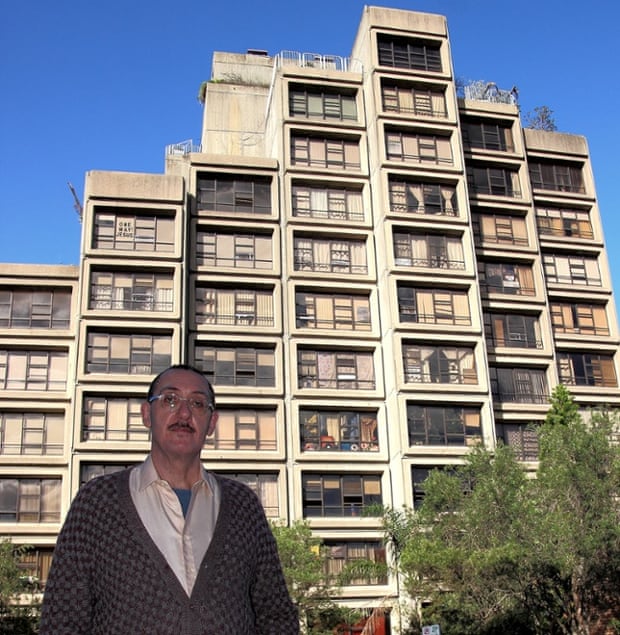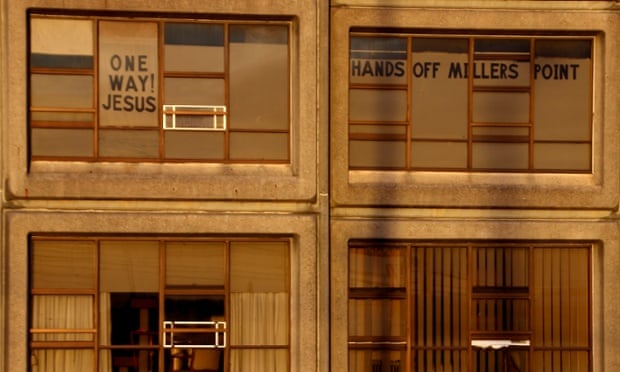Sirius is prominently located right in the middle of The Rocks, a Sydney conservation precinct. I'm pleased to speak today about the historical importance of the Sirius apartment complex and its site. I'm Mary Sutton and I've always loved the Sirius building for its;-impressive sandstone hill site,
-bold architecture,
-innovative adaptation of art, and
-collaborative design
All elements that have seamlessly combined to provide treasured homes for the residents since Sirius was constructed in 1979.
Sirius was built following a lengthy period of discussions and negotiations. Sirius arose out of The Rocks 1970’s Green bans, a movement prominently associated with Jack Mundey, a later patron of the Friends of the Historic Houses Trust.
Richard Roddewig, in his book ‘Green Bans: The Birth of Australian Environmental Politics - A Study in Public Opinion and Participation’, writes
‘In 1975, a major compromise was reached. Green Bans were lifted on three specific sites. The Sydney Cove Redevelopment Cove Authority, in conjunction with The Housing Commission of New South Wales, proposed to develop on one of the sites as eighty housing units, in a medium-rise, nine-story building, for affordable income persons’.
A welcoming brochure was produced in 1979 for the newly housed residents by The Housing Commission of New South Wales. The brochure proudly noted that:
‘The stepped roofline and face of the building were planned to blend and harmonise in good neighbourly fashion with the general roofscape of The Rocks. Shading precast concrete sills surround bronze anti-sun glass resiliently mounted to reduced noise and glare.
The new building has been named “Sirius” in honour of the First Fleet, HMS “Sirius” and her commander, Captain Arthur Phillip. Off the main entrance foyer is a large community room,the “Phillip Room” with generous outdoor plaza, tasteful furnishings, kitchen facilities & toilets.
The Housing Commission’s apartment building makes a spectacular addition to the transformation and restoration of The Rocks, Sydney’s most historic neighbourhood, near where in the early days the Tank Stream, flowing into the bay, provided drinking water for the tiny new colony. Cave shelters, humpies, stone cottages~all were stuff of the Colony’s history.’
As my fellow speaker Charles Pickett, a curator and noted architecture author has just commented
‘A small number of public housing towers were ground-breaking architecturally and widely influential. Some public housing complexes were so successful architecturally that they eventually became sought-after and expensive addresses. Le Corbusier’s Unite d’Habitation at Marseille, Lafayette Park, Detroit by Mies van der Rohe and London’s Barbican Estate are perhaps the best known. For much of the twentieth century the Australian housing authorities also worked at the cutting edge of housing theory and practice. Sirius is a success story of public housing design.
Sirius is a special building – not generic in format like much public housing, Sirius shows the potential of architecture geared to its site and its residents. It deserves to continue to be a part of The Rocks. ’
Most mornings I stroll along Gloucester Walk in The Rocks with Sirius sitting high on the prominent land of Bunkers Hill. The Sirius building always looks imposing. I think of the Sirius building as ‘concrete poetry’.
Photographs taken from the 1979 residents ‘welcoming brochure’ (above and below) depict the simple, but innovative, off-form concrete walls, combined with acid-etched picture windows, to produce Sirius’ distinct stabled building block appearance, reminiscent ‘of a Native American pueblo’.
Sirius shares ‘the magnificent panorama of the harbour in all its moods, the exciting city skyline, and nestling against the Harbour Bridge approaches…..just across the water from the famed Opera House.’
Earlier this year, I had the opportunity to showcase what some may call an ‘unpolished diamond’ to the seven members of the NSW Government's Legislative Council Housing Select Committee.
Thank you to The Hon Paul Green [Chair] and the members of the Upper House Committee for taking the time to see first hand why the Sirius building is an architectural, heritage and mixed tenure, social housing success - a cost effective asset for Sydney - the best example I know of 'Concrete Poetry'.
The Sirius apartment building is named after Governor Phillip's First Fleet vessel, HMS Sirius - a vessel scarcely larger than a Manly ferry - an adventurous little vessel that traversed the world's seas with its unwilling passengers to arrive in Sydney in January 1788.
Sadly, this crucial supply vessel was sunk at Norfolk Island whilst landing vital food supplies and lost forever to the fledging Sydney Cove community on 19 March, 1790. George Raper, a naval officer and illustrator, recorded this melancholy event in his wonderful drawing held by the National Library of Australia and depicted in the drawing (below courtesy of National Library of Australia) you have today.
We are now gathered because of a second equally significant 19 March Sirius event – an announcement by the NSW Government earlier this year on that date that is writing another chapter in the history of the Sirius building.
What I'd like you to consider today is what makes Sirius and its site so notable. I must start by noting that the Sirius building sits prominently on land owned by the Sydney Harbour Foreshore Authority (SHFA) and part of the answer to the question, I think, lies with the vision of SHFA "to make unique places in Sydney that the world talks about".
‘Does the Sirius building and its location satisfy this SHFA vision?’ you might ask. ‘Is the Sirius building and its location a ‘unique place in Sydney that the world talks about’? It seems ‘yes’.
We have heard much today of the uniqueness of the Sirius building, particularly its architecture and concrete construction and its international recognition as such.
There is also much historical evidence of the uniqueness of Sirius’ Bunkers Hill location, as depicted in:
* the earliest colonial drawings of
-John Eyre,
-Jacob Janssen,
-Thomas Watling,
-Richard Read,
-Joseph Lycett,
-Conrad Martens, and
-Frederick Garling,
* Governors' Phillip, Hunter and King's official Colony papers, and
* all the way through to the sights and sounds as you stroll along Gloucester Walk today, as many Sydney and international visitors do.
 |
Richard Read ‘View from Bunkers Hill Including Dawes Battery, Fort Lachlan & South Head Lighthouse’ c.1820 Mitchell Library (above)
|
 |
Conrad Martens ‘View Sydney Cove from Bunkers Hill July 2, 1836’ Mitchell Library of NSW (above)
|
From what we've just heard from some of the other speakers, there is no doubt in my mind that the Sirius building and its location are unique places in Sydney that the world talks about – something that SHFA and the residents of Sydney and Australia can quite rightly be proud of.
The Sirius building and its location are social, tourism, educational, cultural, commercial and conservation assets for NSW.
The world has talked of Sirius' and it location in many ways, including:
1. The opportunistic sailor who foundered the colonial whaling industry and sometime Liverpool, Hawkesbury River and Hunter Valley farmer, Ebenezer (Eber) Bunker, is said by Governor Hunter to have ‘cultivated in a style one would expect from a sailor’, (SMH 2/3/29). Captain Bunker was granted the site on which the majority of the Sirius complex now stands, for some services to Governor King, a site that was known until at least the 1830's as Bunkers Hill.
Eber Bunker was a master mariner and landholder credited with being the "father of Australian whaling". The Sydney Morning Herald of 2 March 1929 records, ‘On his vessel being moored in Port Jackson in 1791 he had an interview with Governor Phillip and astounded that gentleman by his calculations of the possible great profits for a whaling industry for the new settlement…..Within six months he had secured 600 barrels of oil to enhance the interests of the Colony ( and no doubt himself).’
Bunker’s arrival in New South Wales in 1791 was as master of the ship “William and Ann" (with 185 involuntary passengers aboard), one of the whalers chartered to bring early prisoners to ‘Botany Bay’. He then went whaling in the South Seas and he later accompanied the "Lady Nelson" in the vessel "Albion" to establish the Derwent settlement in Tasmania in 1803.
Bunker brought his family to the Colony in the "Elizabeth" in August 1806. He became a landholder at Bunkers Hill, Liverpool, Bankstown on the Hawkesbury and the Hunter Valley. Bunker had built a stone house and stores atop Bunkers Hill (replacing his earlier wattle and daub c. early 1800’s structure) and from this high ground in The Rocks with views to the Heads, Kirribilli and the Parramatta River, Eber ran his global whaling empire.
 |
Watercolour Eber Bunker, c.1810. Courtesy State Library of New South Wales
|
Eber Bunker’s achievements in having the world talk about him also included presenting the first West Australian black swan to the King of England and some cumbersome limited use weaponry to Hawaii's king to support a request ‘to be kind to the missionaries’, (SMH 2/3/29), together with naming Bunkers Islands in Queensland and various New Zealand islands.
Eber Bunker’s house stood on Gloucester Street at Bunkers Hill from 1806, later hemmed in by taller, more elegant terraces, with his house being demolished around 1912 as part of the Rocks reconstruction works (Sirius was built on the central part of this land in 1977-1979).
2. The HMS “Sirius” association represents a tangible link to the most significant vessel associated with early migration of European people to Australia and to the “Sirius” midshipman, Captain Henry Waterhouse, a godson of Prince Henry, the younger brother of King George lll. Some short time after his arrival in the Colony, Captain Waterhouse was granted land on which the northern apartments of the present Sirius complex now sit. HMS “Sirius” was guardian of the first fleet during its epic voyage to Australia between 1787 and 1788, which brought the convicts, soldiers and sailors who became Australia’s first permanent European settlers.
HMS “Sirius” was also the mainstay of early colonial defence in New South Wales and the primary supply and communication link with Great Britain during the first two years of the settlement (Source: Heritage Council of Australia).
The careers of the first three governors’ of the colony of New South Wales, Arthur Phillip (1788-1792), John Hunter (1795-1800) and Philip Gidley King (1800-1806) are closely associated with the history of HMS “Sirius” as all three sailed as senior officers on board HMS Sirius during the voyage of the first fleet to New South Wales. Hunter was also Captain of HMS “Sirius” during its last ill-fated voyage in 1790, when it was totally wrecked at Norfolk Island. The loss of HMS “Sirius” at Norfolk Island on 19 March 1790 was a disaster for the fledgling colony during a period of crisis, when the settlement at Port Jackson was in danger of collapse and abandonment.
It has been argued by some that the adaptability, ingenuity and grim determination to survive, demonstrated by the colonists at Port Jackson and Norfolk Island following this disaster, became an enduring trait of the Australian people.
3. Wharf Owner Robert Campbell, Cumberland Place, Bunkers Hill and Waterhouse Land.
 |
F Garling’s c.1840 “Sydney Cove” a view towards Bunkers Hill (center), Lower Fort St and Dawes Battery Mitchell Library
|
Captain Waterhouse left Australia permanently in 1800 and leased his grant covering part of the Sirius site to Campbell Cove's famous wharf owner Robert Campbell. In the 1830’s the town leases, grants and permissive occupancies of the past were formalized and Robert Russell produced section plans showing the owners of the land (SHFA Heritage and Conservation Register). This part of the site remained unoccupied land until the 1840’s, as did much of Bunkers Hill land surrounding Bunker’s house in current Gloucester Walk. In the 1820's Robert Campbell developed the prestigious landholding of Cumberland Place, designed by Francis Greenway, on his Bunkers Hill land, adjacent to his Waterhouse grant and nearby wealthy Dawes Point wharf and landowners. Garling captures Bunker’s Hill c.1840 above.
4. The Mitchell Library's benefactor, David Mitchell, was born in 1836 in Campbell’s Bunkers Hill’s elegant ‘cottage ornee’ at Cumberland Place (since demolished) and Mitchell spent his childhood there before moving with his large library to modern digs in Darlinghurst. Mitchell famously collected colonial documents associated with Bunkers Hill, (Sirius' site) and all aspects of Colonial Sydney maps, art and memorabilia to found the Mitchell Library Collection.
5. Australia’s first Prime Minister Edward Barton lived as a child in the 1850’s in one of the Young’s townhouses. This four storied townhouse (three stories with a basement kitchen) was one of a terrace of three houses built by Adolphus Young on land developed adjacent to Bunker's land on Gloucester Walk in the early 1840’s and may have been designed by John Verge’s protégé, John Bibb, (who also built the nearby Mariners Church). The imposing terrace of three homes survived until the early 1900's Rocks reconstruction project. This land forms part of the Sirius site today.
6. Innovative concrete technology and an early example of Australian public town planning can still be readily viewed as the Federal Electrical Company (Ajax Building) on the corner of Gloucester Walk and George Street – also a part of the “Sirius” Captain Waterhouse's land grant. This concrete technology and the Arts and Craft movement design of the building, was developed by the recently formed New South Wales Housing Board’s architect, William Henry Foggitt, in association with the Public Works Department, for The Rocks reconstruction works during the period 1912-15. Occupiers included Young and Stewart cordial manufacturers.
In January 1915, the Sydney Morning Herald reported this was the first building in Sydney to be constructed entirely of reinforced concrete. The building was a warehouse, with an office building on the top of the southern end of the building. Several bays of the building’s southern end and the office building were demolished when the Sirius complex was built. This inspirational concrete technology was later used on Millers Point’s High Street flats. Concrete's innovating impact was a feature of the inspirational Sirius building constructed by Anderson & Lloyd, described as a ‘bold and exceptional experiment’ in ‘Concrete’s Rearview’.
7. Sirius now sits on the location of a major employer in the Rocks, Rowans Bond and The Federal Electrical Company, (Ajax Building) that utilised modern loading and storage technology.
8. Sirius was the 1986 setting for the movie of Ruth Park's popular novel ‘Playing Beatie Bow’.
Sirius in 2014- the continuing conversation
The most recent example of the world talking of the Sirius building, and its rare and important position in Sydney, was in response to the NSW Government's 19 March 2014 announcement of the sale of the Sirius building, which was reported in local and international press.
People have also commented recently about the Select Committee's hard won recommendation, I think directed at the Sirius building, that the NSW Government, when selling multi-unit properties in the Sydney area, include in the contract for sale, a requirement that at least 10 per cent of all dwellings on that site be allocated as social, public and affordable housing.
Each unique aspect I've cited has stamped its mark on the Sirius building and its location as a rare and important place talked about in the world's press and by visitors. For me, I'm attracted to the description of the Sirius building as simply "concrete poetry".
I imagine that SHFA and all of Sydney must regard the interest in the Sirius building and its site, and modern day Bunkers Hill including Gloucester Walk, as an inspired and visionary success.
In concluding, you have heard much today about the Sirius building and its location and I invite you to walk around the Rocks and take time to ponder all that's been said.
Consider the "concrete poetry" of the Sirius building, its location and its history. Its connection to Sydney's past and the value of its contribution to the present and what may be its future.
If you would like to continue the conversation, the Minister for Heritage, the Hon. Rob Stokes address is 52 Martin Place, Sydney 2000 and I'm sure he'd be interested in hearing your view.
Thank you for your time.
 |
Photograph of Sirius Level 8 Balcony by Mary Sutton ~ March 12 2014 Site Visit with the Legislative Council Housing Select Committee
|
RESOURCED :
http://tunswblog.blogspot.com.au/2014/12/sydneys-concrete-poetry.html






 Millers Point: a community under the hammer
Millers Point: a community under the hammer













